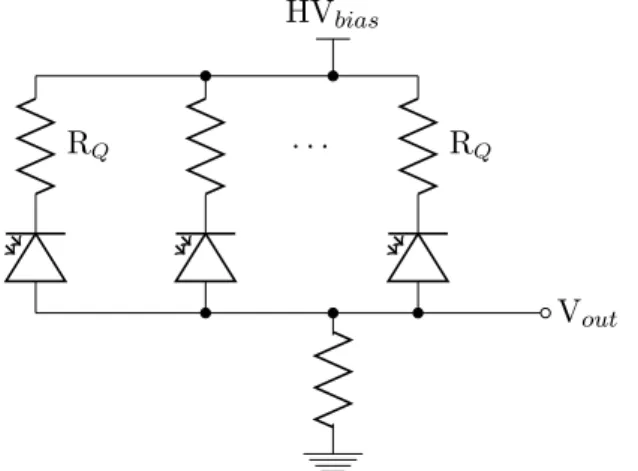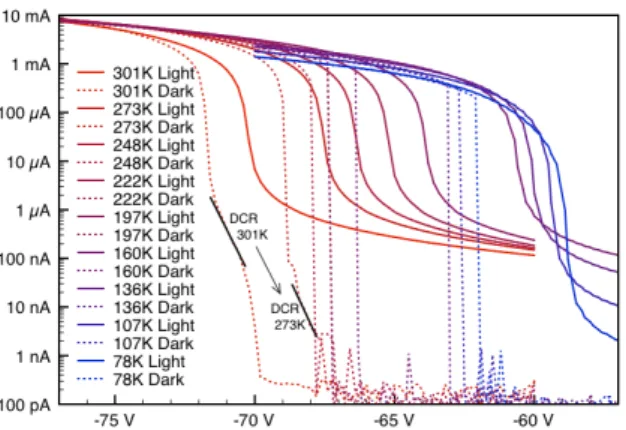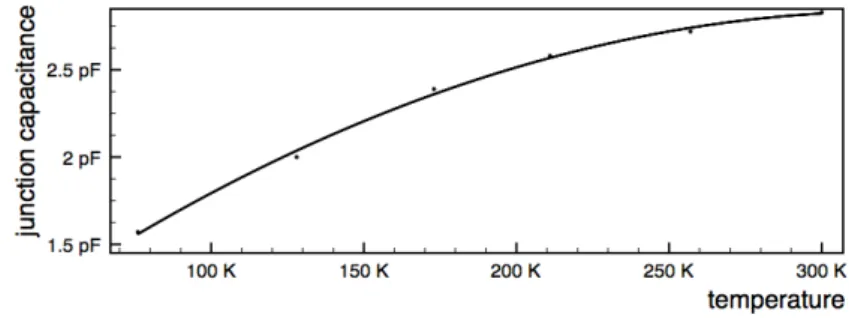HAL Id: hal-00932628
https://hal.archives-ouvertes.fr/hal-00932628
Submitted on 22 Jan 2014
HAL is a multi-disciplinary open access
archive for the deposit and dissemination of sci-entific research documents, whether they are pub-lished or not. The documents may come from teaching and research institutions in France or abroad, or from public or private research centers.
L’archive ouverte pluridisciplinaire HAL, est destinée au dépôt et à la diffusion de documents scientifiques de niveau recherche, publiés ou non, émanant des établissements d’enseignement et de recherche français ou étrangers, des laboratoires publics ou privés.
SiPM cryogenic operation down to 77 K
D. Prêle, D. Franco, Dominique Ginhac, Khalil Jradi, F. Lebrun, S. Perasso,
Denis Pellion, A. Tonazzo, F. Voisin
To cite this version:
D. Prêle, D. Franco, Dominique Ginhac, Khalil Jradi, F. Lebrun, et al.. SiPM cryogenic operation down to 77 K. 10th International Workshop On Low Temperatures Electronics (WOLTE10), Oct 2013, Paris, France. pp.30-34. �hal-00932628�
SiPM cryogenic operation down to 77 K
D. Prˆele1 , D. Franco1 , D. Ginhac2 , K. Jradi2 , F. Lebrun1 , S. Perasso1 , D. Pellion2, A. Tonazzo1, F. Voisin1,1APC, Univ. Paris Diderot, CNRS/IN2P3, CEA/Irfu, Obs. de Paris, Sorbonne Paris Cit´e,
Paris, France
2Le2i, Univ. de Bourgogne, CNRS/INSIS-INS2I, Dijon, France
E-mail: damien.prele@apc.univ-paris7.fr
Abstract. Silicon PhotoMultiplier (SiPM) is composed of extremely sensitive photosensors based on the Geiger Mode Avalanche PhotoDiode (GM-APD), which operate as a digital pixel sensitive to single photons. SiPMs are being considered for applications in low temperature environments, such as noble-liquid detectors for dark matter searches or neutrino physics and GM-APD is promising technology for space Compton telescopes. While it is well known that the dark count rate, one of the main limitations of SiPM, is reduced at low temperature, a detailed study of the behavior of the device in cryogenic environment is necessary to assess its performances. In this paper, we present measurements of static parameters as breakdown voltage and quenching resistance of a commercial SiPM (Hamamatsu MPPC S10362-11-100C). Evolution of these parameters as well as junction capacitance between room temperature and 77 K is discussed.
1. Introduction
Silicon PhotoMultipliers (SiPMs) are being considered as possible photosensors for detectors operating at low temperatures, such as noble liquid (argon or xenon) time projection chambers for direct dark matter searches and neutrino detectors, or for Compton telescopes in space. A detailed study of their parameters in cryogenic environment are necessary to assess the expected performances.
A SiPM is composed of Geiger Mode Avalanche PhotoDiode (GM-APD). Geiger mode provides internal gain as large as 106
carriers per incident photon. By means of a self-sustaining avalanche process: successive impact ionizations of carriers are accelerated as long as the electric field is sufficient, above a voltage breakdown threshold (VBD). The GM-APD current rises to
the order of a milli-ampere in a few nano-secondes (rise time). This current passes through a quenching resistor [1] (RQ in Fig. 1), placed in series with the voltage biasing, which has
the effect of lowering the electric field in the GM-APD below the breakdown threshold. This causes the avalanche process to be turned out in few 10 ns (fall time). Without self-sustaining avalanche process and as long as there is no new incoming photon, the current drops below the pico-ampere level (leakages), and the GM-APD electric field is restored above the breakdown threshold. After this current pulse, the GM-APD is again ready to detect a new photon.
The main parameters of a GM-APD, and thus of a SiPM, are: the quenching resistance RQ,
influencing the fall time; the junction capacitance CJ, which limits the rise and fall times and the
resistance of the junction Rdj during the avalanche process is also an interesting parameter
allowing to determine the rise time. HVbias
RQ . . . RQ
Vout
Figure 1. Electrical scheme of a SiPM showing the individual GM-APD and the quenching resistors RQ. A small resistor
(typically 50 Ω) in series with the SiPM and the high voltage bias (≈ 70 V in the case of the MPPC) converts the current to voltage.
t rise time ∝CJRd j fall time ∝CJRQ
Figure 2. Typical current waveform crossing a GM-APD cell when photon is detected. A GM-APD pulse consists of two parts, rise and fall. The rise time depends to the value of the differential resistance Rdj of the diode during
the avalanche process and of the junction capacitor CJ, while the fall time depends to
RQ and CJ.
We determined the parameters VBD, RQ and CJ as a function of temperatures for a
commercial SiPM, the Hamamatsu MPPC S10362-11-100C [2]. Most of parameters were extracted from the Current-Voltage characteristic (I(V), see Fig. 3) from 300 K to 77 K. Only, junction capacitors is obtain from dynamic measurements. This allows us to know what kind of cryogenic operation we can expect from the photosensor in cooled environements.
2. Quenching resistance extraction from the forward bias characteristic
Using the forward bias characteristic of the SiPM, it is possible to extract the value of the quenching resistor RQ. We assume that N cells under forward bias are similar to a single diode
in series with a RQ/N resistor1.
Following this method to extract RQ, we have measured the forward characteristic of the
MPPC S10362-11-100C from 300 K to 77 K. Figure 4 shows the I(V) forward characteristics
1 SiPM ≡ Diode + R
Q/N. Indeed, N diodes in parallel are equivalent to one diode with an area N times larger,
where the small-signal equivalent resistance is always rd=kTqI whatever N.
Figure 3. Typical SiPM I(V) characteristic at 300 K with and without incident photons. A zoomaround the breakdown voltage is also shown using a log scale of the current absolute value.
from room temperature to liquid nitrogen temperature. The slope of the curve is inversely proportional to the quenching resistance, so we clearly see that quenching resistance increases at low temperatures. Figure 5 shows the quenching resistance deduced from I(V) curves. It is noticeable that the quenching resistance increases more quickly as the temperature decreases and finally is 10 times larger at 77 K than at 300 K.
Figure 4. I(V) curves show that the quenching resistor increases at low temperature. Indeed, in an I(V) curve, the resistance is inversely proportional to the slope of the curve.
Figure 5. Quenching resistance RQ as a
function of the temperature. RQis extract from
the figure 4 and by multiplying RQ/N by the
number of SiPM cells (N=100).
The quenching resistance (per cell) goes from 100 kΩ at room temperature to 1 MΩ at liquid nitrogen temperature. As a consequence, for a constant junction capacitance, the fall time will increases by an order of magnitude. This RQ(T) negative temperature coefficient could inhibit
the quenching process. Indeed, during the fall time, the Joule heating could reduce the RQ
resistance and would lead to stay in the avalanche process. This is probably the effect that will be shown in the following section with the reverse bias characteristics (dashed line of Figure 6). 3. Breakdown voltage measurement from the reverse bias characteristic
Reverse bias characteristic is a common way to characterize SiPM and extract the breakdown voltage VBD. As shown in figure 3, the measurement in the dark also allows us to know the
maximum voltage biasing (VZ 2) before SiPM self-triggering.
As it is shown in figure 6, at low temperature the photo-current is too small to be measured by our equipment (Agilent B1500A source measure unit with a noise floor ≈ 100 pA). Moreover, below 250 K, a ”full SiPM latching process” trigs the overall cells unexpectedly above the breakdown voltage even without photon flux (”Dark”). The arbitrary voltage where this latching occurs suggests that it is a different phenomenon than the ”Zener” threshold VZ. Moreover, this
phenomenon could be compatible with a positive electro-thermal feedback due to the negative temperature coefficient of the RQ.
Nevertheless, using a light source to trigger the SiPM, it is possible to clearly see the breakdown voltage, as it shown in figure 6 - solid line. The breakdown voltage is measured and plotted as a function of the temperature in Figure 7. It appears that its evolution is close to a linear function ; with a temperature coefficient equal to -50 mV/K. VBDdecreases by more
than 10 V (in absolute value) from room temperature to liquid nitrogen temperature.
2 The Zener voltage V
Figure 6. Reversed biased I(V) curves of the SiPM. To see small current phenomena a log scale is used, so in absolute value.
Figure 7. Breakdown voltage as a function of temperature. A linear fit gives a fluctuation of the breakdown voltage of −50 mV/K. 4. Dynamic characteristics
SiPMs are used to detect fast pulses, therefore a dynamic characterization is mandatory to determine the SiPM behavior. A small signal analysis allows one to extract the capacitance of the junction reverse biased.
Figure 8 shows the equivalent AC electrical model of the SiPM. Rdj is the differential
resistance of each junction and is only considered in presence of an avalanche process ie biased below VBD(in absolute value). CJis the junction capacitance, which is due to the depleted region
of the APD. The thickness of this depleted layer is proportional to the reverse biasing, therefore the junction capacitor decreases as the reverse bias increases in absolute value. However, as is shown in figure 9, this value remains constant for voltage biases larger than 30 V. Moreover, above VBD, the avalanche process prohibits the measurement of the junction capacitance due
to the drop of the junction differential resistance. HVbias+ac N in // RQ/N I+i
≡
ac Rdj/N RQ/N i N×CJFigure 8. Small signal electrical schematic of a SiPM for ac measurement. Rdj
corresponds to the differential resistance of the GM-APD junction (without RQ). CJ
is the junction capacitor.
Figure 9. Evolution of the junction capacitance as a function of the voltage biasing and for different temperatures from room temperature to liquid nitrogen temperature.
The junction capacitance as a function of temperature, measured with a bias voltage of 60 V, is finally reported in figure 10. We clearly notice a decrease of the junction capacitance at low temperature. However, this decrease is less than a factor of 2 between 300 K and 77 K.
Figure 10. Junction capacitance as a function of the temperature. The measurement has been made with a 60 V biasing.
5. Conclusion
The breakdown voltage VBD, the quenching resistance RQ and the junction capacitance CJ
of a commercial SiPM MPPC S10362-11-100C [2] have been measured at temperatures from 300 K to 77 K. A quasi-linear decreasing of the breakdown voltage with temperature is found, with a rate of -50 mV/K. The quenching resistance increases by a factor of 10 between 300 K to 77 K. Finally, the junction capacitance decreases by less than a factor of 2 in the same temperature range. These experimental results give a good idea of the voltage biasing required for MPPC cryogenic operation. Furthermore, they allow us to predict a fall time increase by a factor of 5 at liquid nitrogen temperature. Moreover, these tests clearly point out a phenomenon of ”full triggering” of the tested SiPM at low temperature and for biasing just above the breakdown voltage. Therefore, the biasing voltage range seems to be strongly reduced at cryogenic temperatures.
Most of these results has been obtained by using ”simple” I(V) measurements and are fully compatible with similar measurements using time response [3].
Acknowledgments
Measurements presented in this paper has been made with the help of B. Manceur during its master degree internship at APC. Authors are also grateful to M. Piat, who provided part of the cryogenic equipment needed for this study.
References
[1] Cova S. et al 1996 Avalanche photodiodes and quenching circuits for single-photon detection (Applied Optics, Vol. 35 No 12)
[2] HAMAMATSU datasheet, MPPC (multi-pixel photon counter) - S10362-11 series
[3] Otono H. et al 2007 Study of MPPC at Liquid Nitrogen Temperature (International Workshop on neaw Photon-Detectors, Kobe, Japan)



